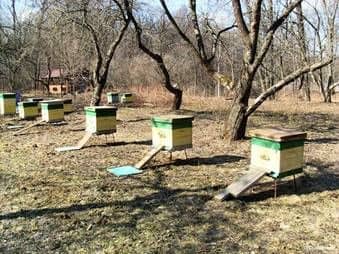
The work begins in mid-March. There is intense melting of snow. What should I do first? Open the external tapholes for 20-30 mm, remove the spoil from it, close the internal ventilation holes in the pallet bar.
The end of March is the middle of April. If bees do not fly around, and about 10 o’clock in the morning the temperature of the air in the shade reaches about 6-8 њ у (in quiet sunny weather), it would be good to make an artificial over-flight flight.
To do this, it is necessary to heat the room to 20-22 њ C. When the temperature on the street (in the shade) reaches 10- 12 њ C, we must give families 200 g of warm syrup in half-liter jars tied with two layers of gauze.
A can of syrup is placed in an inverted state on the central opening in the ceiling above the frames and covered with a pillow.
After warming up the pavilion, the outer insulation should be removed and the enclosures extended 2-3 mm, by inserting
nails of the same diameter between their back walls. Until 13-14 hours the hives will warm up. By this time, the temperature outside, as a rule, reaches 12-14 њ C, and the bees go on flying around.
When the temperature does not exceed 10 њ у in the daytime, the family is at rest, has enough feed, in this case, no additional measures should be taken to stimulate the flight, as bees can get too excited, but they still will not fly out on the fly.
After the flight it is necessary to inspect the families for the quantity and quality of the feed. It should be at least 15-18 kg per family. If the food is enough, you need to put light brown (warmed) honeycombs before filling the buildings. For the purpose of better development, 0.5 liters of warm syrup is poured into each honeycomb.
The absence of crystallization (the presence of sugar crystals on a pallet) and the souring of honey (it flows out of the cells) is checked. If there is little or no honey, then instead of putting empty ones, put warm honeycomb honeycombs or give the syrup to the required amount.
If necessary, it is necessary to transplant the family into clean housing, replace dirty honeycombs. Wax and propolis with clean frames do not need to clean, but remove the scuff from the grid is just necessary. If underdeveloped bees meet, it is a signal that the family is heavily infected with varroa and needs immediate help.
If there is no more than one frame of a printed brood in the family, it must be removed to a collection line – an incubator formed over the family, which must be strengthened. After the release of the entire brood, it should be treated with acaricidal agents (naphthalene or folbek) and attached to the family over which it is formed.
If possible, set for a cold period drinkers for each family at a rate of 200-250 ml of water per day or equip a common heated water tank in a calm, sunny place.
In strong and medium-sized families nests of bees are not cut, but if the lower body is moldy and the bees pass to the upper, the lower one is removed.
It is also important to carefully insulate the nest from the outside by removing the ventilation tubes and closing the lower ventilation holes in the pallet bar.
Without extreme need, it is not advisable to open the hives until the next work, because when the insulation is removed, without warming up the room, the family cools down, and it takes up to 3 days to restore the temperature of the brood nest part, which will delay the development.
If there is a shortage of Perga in the hive, it is better to give the bees a protein candy in the cans installed in the overburden, 0.4-0.5 kg per week. If the bees take it badly, you need to add honey and perga to it. The bank with the candy inverted is placed on the central opening of the ceiling.
Upon the detection of nosematosis, fumagillin (one vial of 5 kg of candy) is added to the candy, and KAS-81 preparation when varroatosis. To prevent the dough from flowing out of the can after the preparation, it is made sufficiently thick and is necessarily heated to 40-45 њ C.
Immediately after cooking, the candy is laid out on the banks, in which it must be kept for several days in a cool place before being put into the hives. If the candy still flows, the bank is put on the net. As canisters for cans can be used metal cans with a capacity of at least 650 ml.
Preparing candy under amateur conditions is laborious, and getting a lot of homogeneous, well-mixed is quite difficult. To improve the quality of candy, it must be passed through the meat grinder after mixing.
Then, in the layers and weak families, you need to put two warm, low-copper frames with printed honeycombs or filled syrup (1 liter per frame), leaving one insulated body with 8-9 honeycombs. To complete the work, it is necessary to clean the pallets and lubricate them with vaseline or other non-drying oil.
Then, during the entire summer season, clean and lubricate the pallets as often as possible, preferably every week. In addition, larvae of wax moths and other pests can be located in the litter of pallets, the amount of which can be easily reduced if in the oil to add boric ointment (about 1/3 of the total) and 3-4 times a season lubricate this composition not only the outside of the pallet, but also the reverse, as well as the side walls on both sides.
Lack of time or unfavorable weather conditions sometimes do not allow to carry out all planned.
Семья из нуклеусов. Как выделывают шкуру крс.
Contents of bees in the pavilion